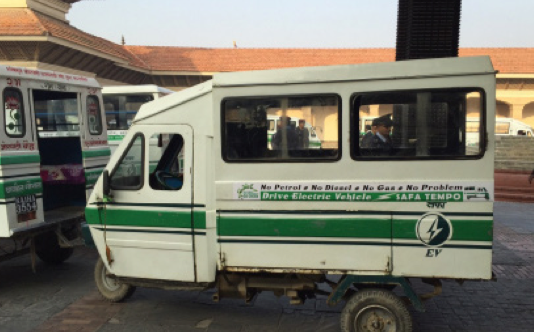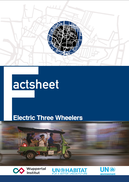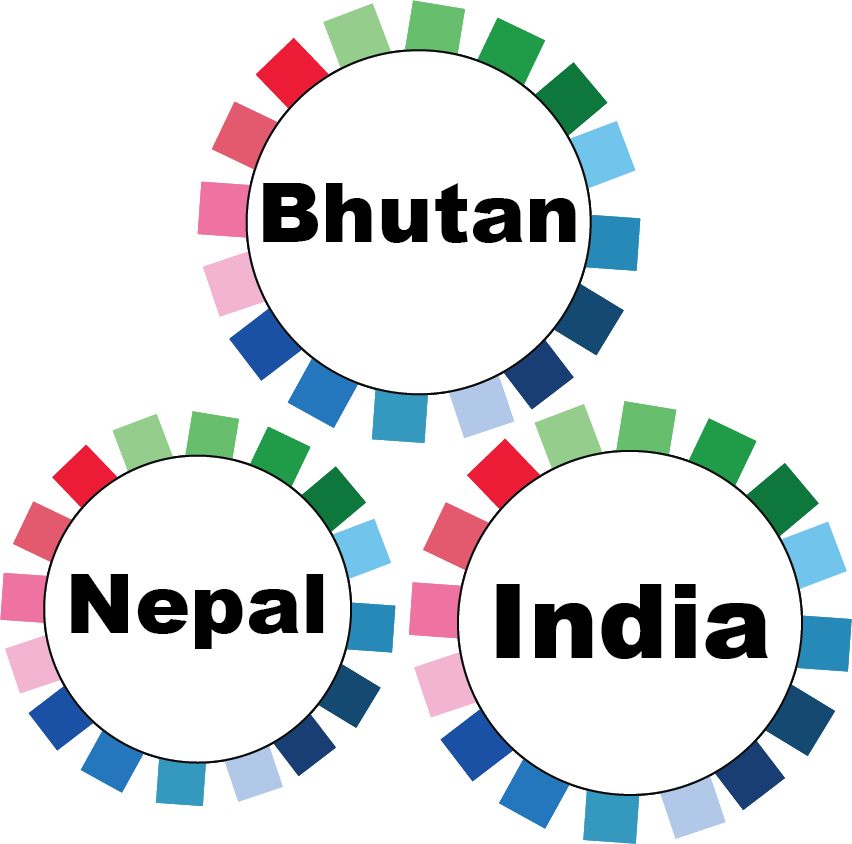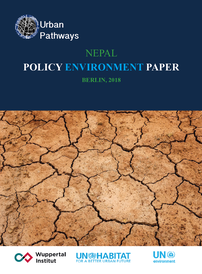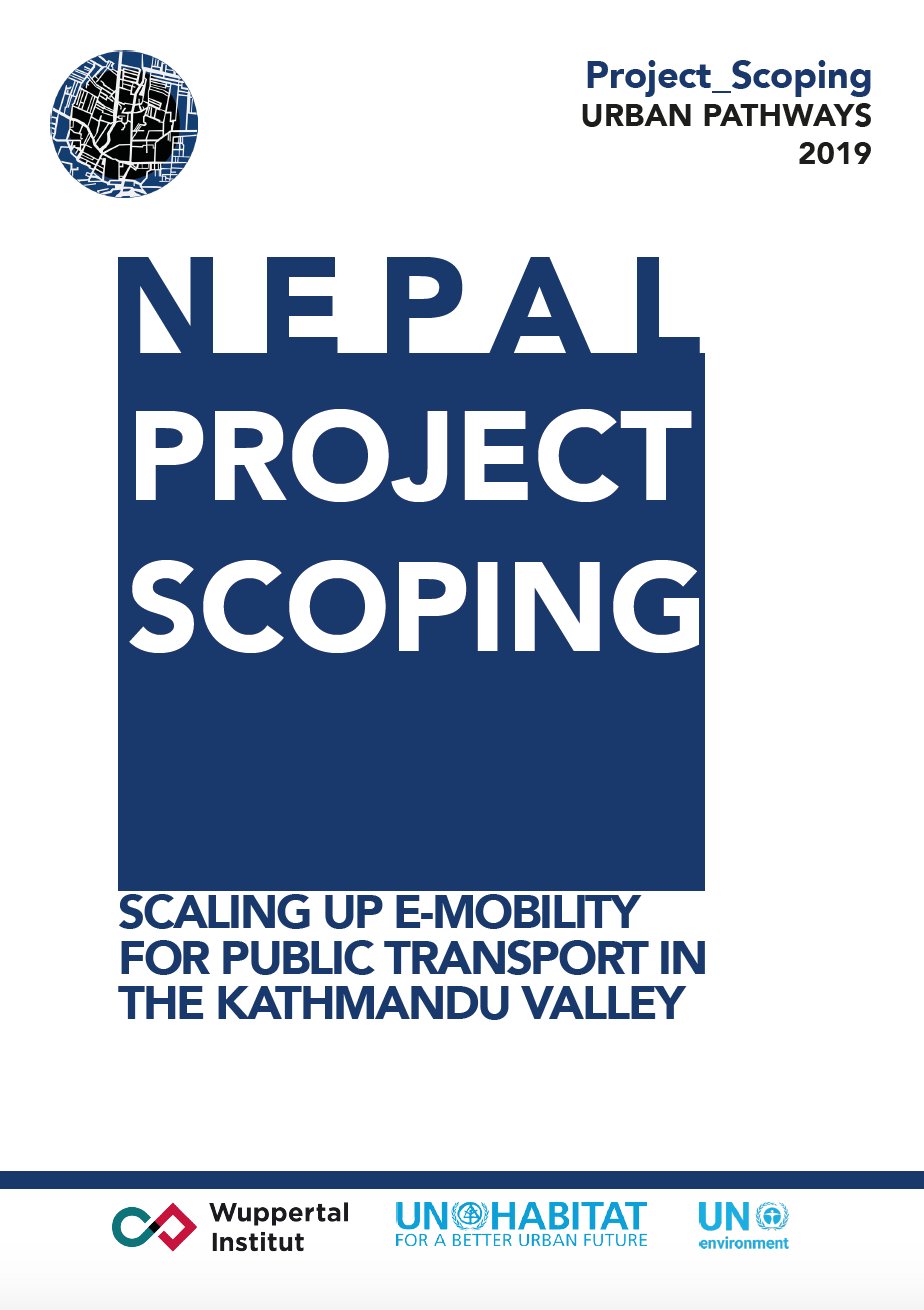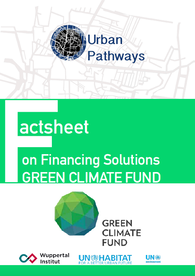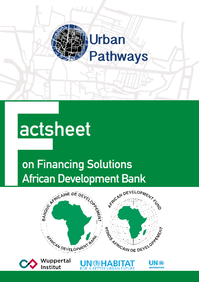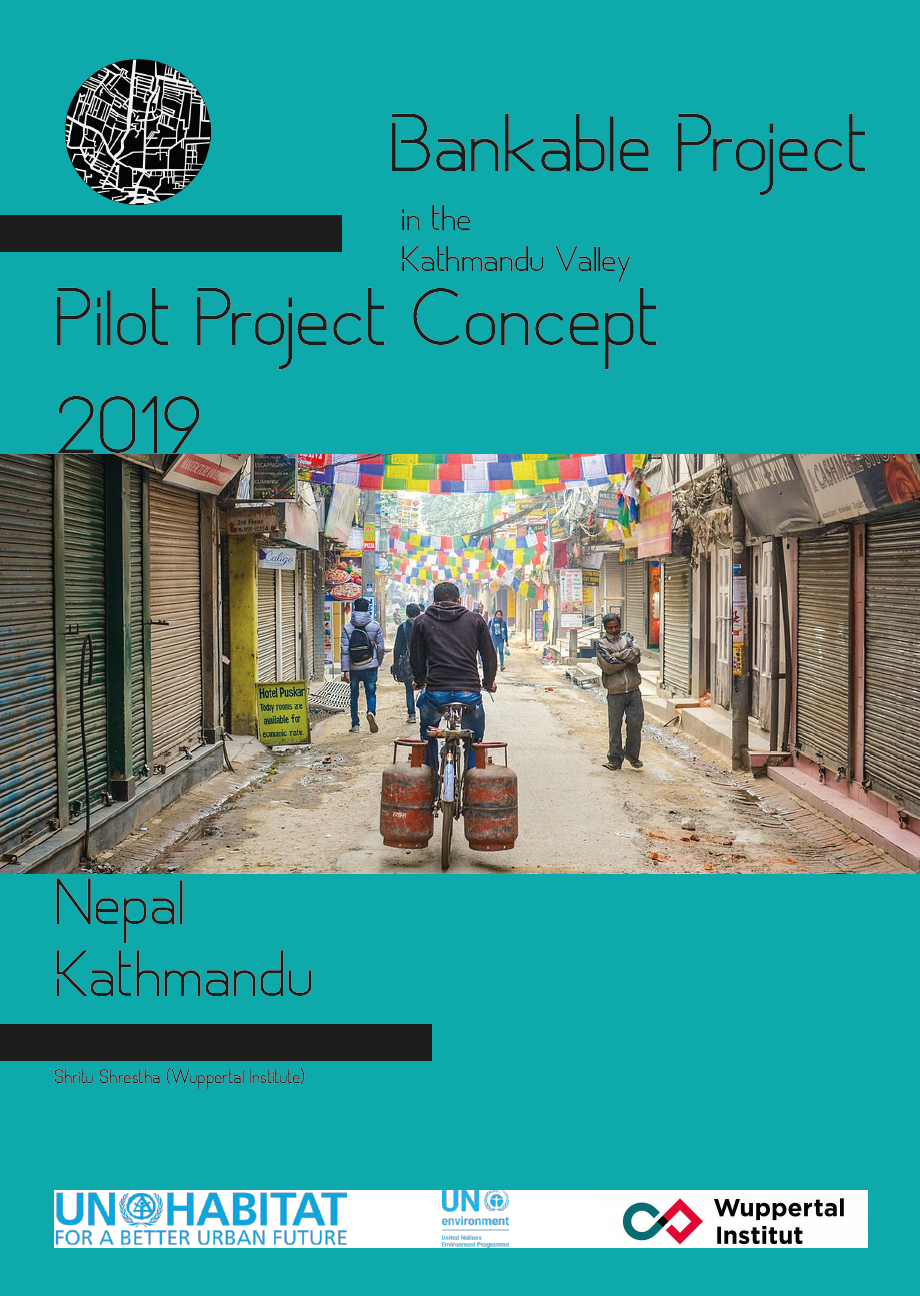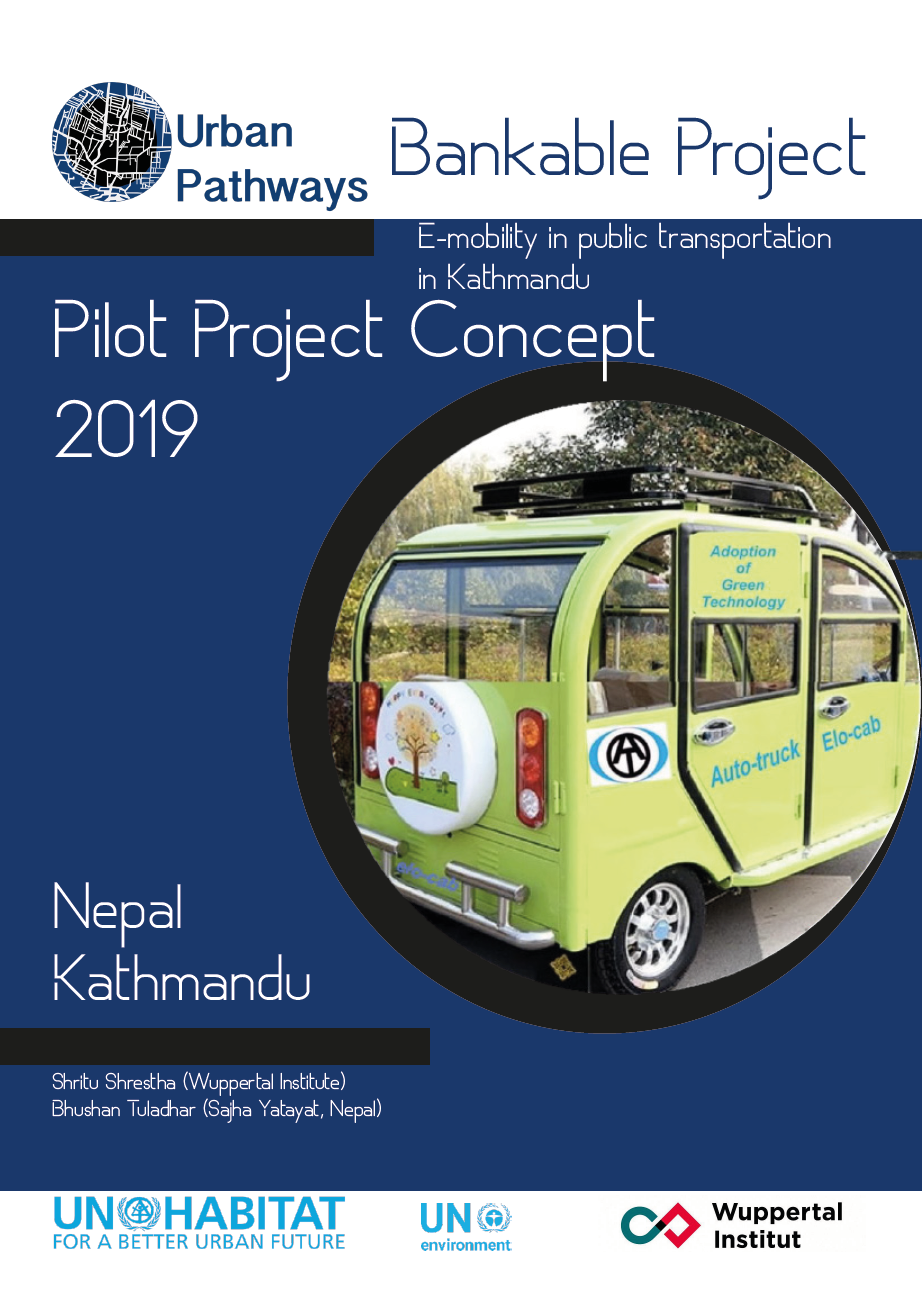|
Vertical Divider
|
Vertical Divider
Toolbox
Status: Steps to action |
Vertical Divider
|
|
The Kathmandu Valley
Kathmandu is the country’s capital and the largest city (population of 1 million), followed by Pokhara, Lalitpur, Bharatpur and Birgunj metropolitan cities (population above 200,000). The Kathmandu valley includes 3 cities – Kathmandu, Lalitpur and Bhaktapur with total area of 570 sq. km. The population of the valley is 2.5 million with annual growth rate of 4.63% (3.5 million unofficial). This represents 9.32% of entire population of country. Some of the initiatives on energy generation/conservation, sustainable transport and waste management in the valley are discussed below. Energy Nepal’s energy consumption is less, but it is growing (grew 27% from 2000 to 2013) with increased urbanisation and economic production (e.g. in industry and transport). Nepal does not have major oil, gas, or coal reserves and the reliance on imported fossil fuel makes it vulnerable. Although Nepal has huge technical potential to generate electricity from hydropower (estimated 83,000MW), currently only 1% of this potential is harnessed (and imports deficit electricity from India). With the completion of new Upper Tamakochi Hydropower project (UTHEP), 456MW of electricity expected to be added by the end of 2018 (Lama, 2017). Nepal has a good potential for photovoltaic solar power and its use has been initiated on the roofs of the Kathmandu valley. Most of solar photovoltaics (PVs) are installed privately on rooftops and are used mainly for lighting the building and operating some appliances. The excess energy generated from solar power are stored in batteries, but are not yet connected to national grid. A policy that allows net metering from any solar power above 500 Watts exist in Nepal but it has not yet been applied in the city (Chalise, 2017). Transport Road transport dominates transport infrastructure in Nepal (cars, bus, motorcycle and marginal non-motorised transport). In the Kathmandu Valley, the number of vehicles registered tremendously rose—an increase of over 12-fold from 45,871 in 1990/1991 to 570,145 in 2010/2011. The highest number of vehicles type in the valley was motorised two-wheelers. Air pollution was the second leading cause of death in one of the main hospitals of the Kathmandu Valley in 2011. To reduce air pollution in the Kathmandu Valley, these 3 measures are urgently required: improving vehicle speed, promoting public transportation, and introducing electric vehicles that could reduce public transportation energy demand by more than 60% (Shrestha, Shrestha, & Shrestha, 2017). Some electric cars and scooters have been introduced in cities. Electrically powered 3 wheeler e-Tuk-Tuk/e-rickshaw (Safa Tempo) is a successful example of public EV in Nepal (e.g. in Kathmandu and in southern part of Nepal), in operation since 1996. Currently, 1,200 e-rickshaws (Safa Tempos) run in Kathmandu (Shahi, 2017). Less than 100 electric cars are in the valley, mainly imported form India, China and South Korea (which is negligible compared to fossil-fueled cars). A few small electric cars are produced in Nepal by Hulas Motor Company as an experiment. Charging infrastructure is in very nascent state in Kathmandu (also in Nepal). Nepal Electrical Authority opened a demo charging station at its office in order to boost public interest in EVs. E-scooters are a solution to replace the growing and highly used fossil fueled scooters in the valley. Public transportation services, currently run by the private sector through individual operators, are still not adequate in the city. The addition of e-bus can improve accessibility and environment. Waste management Nepal’s urban basic services such as water supply, wastewater treatment and solid waste management (SWM) are not well developed, technically and financially. Nepal’s municipal solid waste (MSW) is composed of 56% organic waste, 16% plastics, and 16% paper and paper products in aggregate (ADB, 2013). The Kathmandu valley generates around 1,000 tonnes of solid waste per day. 70% of the trash is dumped in nearby landfill site, without proper waste segregation. The Government of Nepal adopted a Public Private Partnership approach in 2018, Nepwaste Pvt Ltd, a joint venture of Investment Board Nepal (IBN) and Finnish organisations in order to develop and implement an Integrated Solid Waste Management Program for Kathmandu. It will transform informal sector of waste collection into a formal one and assure regular service of household waste collection. It aims to convert organic waste to energy. It is estimated that it will generate 5-7 MWs of electricity, organic fertiliser and fuels. Alternative Energy Promotion Centre (AEPC) has also initiated large scale biogas projects in urban and semi-urban areas of Nepal with the financial support from World Bank under Scaling up Renewable Energy Programme (The Himalayan Times, 2017). Nepal government has imposed a ban on import, storage, sale, distribution and use of plastic bags below 40 microns (The Himalayan Times, 2018), but due the lack of enforcement it is not fully implemented. |
|
E-learning Programme
Status: In progress Learning resources on Mobility, Energy and Waste Management E-learning programme builds on the toolbox and factsheets and aims to provide a better understanding of possible actions, highlighting the experiences from the implementation of measures in other cities building on the wealth of knowledge of international experts. |
|
Action Tracker
Status: In progress Gives an overview of the Projects progress The Urban Pathways Action Tracker provides an overview of the project’s activities in the cities and reflects on the various action areas. The main objective of this is to share learnings with other cities and identify opportunities for synergies with other projects and initiatives. |
|
Capacity Building
Status: In progress
|
|
Urban Change Maker
Status: In progress The Urban Change Maker Programme actively trains and involves motivated junior and senior experts to contribute our joint effort of delivering on the New Urban Agenda with concepts for low-carbon urban energy, mobility and waste management systems. |
|
City-to-City Partnerships
Status: In progress The partner cities will be supported by exchanging ideas with their peers in other cities who have developed successful urban mobility, energy and resource management solutions. This will focus on the story behind the success on governance, finance and regulatory issues.
|
|
Regional Replication
Status: work on progress Urban Pathways events on mobility and waste under ‘environMENTALISE’ initiative Urban Pathways is organising several events under an initiative ‘environMENTALISE –co-creating safe, friendly and green neighbourhoods’ in cities in Latin America, Africa and Asia that contribute to raising awareness about the environmental, health, social and economic benefits of non-motorised transport, as well as of waste reduction. EnvironMENTALISE, an initiative of Wuppertal Institute, UN-HABITAT and UN Environment under the Urban Pathways project, includes awareness raising and capacity building activities on-site (car-free day, tactical urbanism, etc.) and online (webinars). For this purpose, Urban Pathways is collaborating with municipalities and local stakeholders in the region and cooperating with several organisations (such as ITDP Mexico, WRI India, ICLEI, FabLab Barcelona and Ciudad Emergente) and initiatives (such as World Habitat Day 2019, Waste Wise Cities Campaign, European Mobility Week 2019, Day of walking and cycling to school 2019, African Mobility Month). The participating cities will be provided with an air quality monitoring device ‘Smart Citizen kit’ to measure the impact of the activities on-site. The cities joining the initiative are Belo Horizonte (Brazil), Quito (Ecuador), Aguascalientes (México), Cuenca (Ecuador), Kochi (India), Nairobi (Kenya), Kampala (Uganda) and Kathmandu (Nepal). |
|
Policy Environment Assessment
Status: Finished Nepal´s Nationally Determined Contributions:
Nepal aims to reduce about 14 million tones of CO2 emission and targets a 80% share of renewable sources in its energy mix by 2050, reducing its fossil fuel dependency by 50%. Population of 29.529.631 (2017) National GDP 21.14 billion USD (2016) Nepal’s Nationally Determined Contribution (NDC) Nepal is one of the least contributors to the greenhouse gas (GHG) emissions. As of 2010, Nepal’s own emissions bring about less than 0.1% of global emissions. With the current policies, Nepal’s GHG emissions are expected to increase to between 50–53 MtCO2e by 2030 (an increase of 55–66% compared to 2010 levels). Even with this increase, the country’s per capita emissions would only grow from 1.2 tCO2e/cap as of 2010 to 1.5–1.6 tCO2e/cap by 2030, still far below the 2012 world average of 7.6 tCO2e/cap. But Nepal is highly vulnerable to climate change which has a negative impact on its people, property and natural resources (Government of Nepal, 2016). Nepal’s Nationally Determined Contribution (NDC) was submitted in October 2016. In its Paris agreement targets, it has plans to build resilience to climate change impacts as well as to reduce greenhouse gas (GHG) emission with an intent to move to a low carbon economic development pathway - but has not outlined a clear overall GHG emission reduction target or commitment (Climate Action Tracker, 2017). Transport Road transport dominates transport infrastructure in Nepal (cars, bus, motorcycle and marginal non-motorised transport). In the Kathmandu Valley, the number of vehicles registered tremendously rose—an increase of over 12-fold from 45,871 in 1990/1991 to 570,145 in 2010/2011. The highest number of vehicles type in the valley was motorised two-wheelers. Air pollution was the second leading cause of death in one of the main hospitals of the Kathmandu Valley in 2011. To reduce air pollution in the Kathmandu Valley, these 3 measures are urgently required: improving vehicle speed, promoting public transportation, and introducing electric vehicles that could reduce public transportation energy demand by more than 60% (Shrestha, Shrestha, & Shrestha, 2017). Some electric cars and scooters have been introduced in cities. Electrically powered 3 wheeler e-Tuk-Tuk/e-rickshaw (Safa Tempo) is a successful example of public EV in Nepal (e.g. in Kathmandu and in southern part of Nepal), in operation since 1996. Currently, 1,200 e-rickshaws (Safa Tempos) run in Kathmandu (Shahi, 2017). Less than 100 electric cars are in the valley, mainly imported form India, China and South Korea (which is negligible compared to fossil-fueled cars). A few small electric cars are produced in Nepal by Hulas Motor Company as an experiment. Charging infrastructure is in very nascent state in Kathmandu (also in Nepal). Nepal Electrical Authority opened a demo charging station at its office in order to boost public interest in EVs. E-scooters are a solution to replace the growing and highly used fossil fueled scooters in the valley. Public transportation services, currently run by the private sector through individual operators, are still not adequate in the city. The addition of e-bus can improve accessibility and environment. Energy Nepal’s energy consumption is less, but it is growing (grew 27% from 2000 to 2013) with increased urbanisation and economic production (e.g. in industry and transport). Nepal does not have major oil, gas, or coal reserves and the reliance on imported fossil fuel makes it vulnerable. Although Nepal has huge technical potential to generate electricity from hydropower (estimated 83,000MW), currently only 1% of this potential is harnessed (and imports deficit electricity from India). With the completion of new Upper Tamakochi Hydropower project (UTHEP), 456MW of electricity expected to be added by the end of 2018 (Lama, 2017). Nepal has a good potential for photovoltaic solar power and its use has been initiated on the roofs of the Kathmandu valley. Most of solar photovoltaics (PVs) are installed privately on rooftops and are used mainly for lighting the building and operating some appliances. The excess energy generated from solar power are stored in batteries, but are not yet connected to national grid. A policy that allows net metering from any solar power above 500 Watts exist in Nepal but it has not yet been applied in the city (Chalise, 2017). Waste management Nepal’s urban basic services such as water supply, wastewater treatment and solid waste management (SWM) are not well developed, technically and financially. Nepal’s municipal solid waste (MSW) is composed of 56% organic waste, 16% plastics, and 16% paper and paper products in aggregate (ADB, 2013). The Kathmandu valley generates around 1,000 tonnes of solid waste per day. 70% of the trash is dumped in nearby landfill site, without proper waste segregation. The Government of Nepal adopted a Public Private Partnership approach in 2018, Nepwaste Pvt Ltd, a joint venture of Investment Board Nepal (IBN) and Finnish organisations in order to develop and implement an Integrated Solid Waste Management Program for Kathmandu. It will transform informal sector of waste collection into a formal one and assure regular service of household waste collection. It aims to convert organic waste to energy. It is estimated that it will generate 5-7 MWs of electricity, organic fertiliser and fuels. Alternative Energy Promotion Centre (AEPC) has also initiated large scale biogas projects in urban and semi-urban areas of Nepal with the financial support from World Bank under Scaling up Renewable Energy Programme (The Himalayan Times, 2017). Nepal government has imposed a ban on import, storage, sale, distribution and use of plastic bags below 40 microns (The Himalayan Times, 2018), but due the lack of enforcement it is not fully implemented. |
|
|
|
Funding Solutions
Status: Work in progress An overview of funding solutions is provided in the toolbox. This section includes updates on the specific funding options that are considered for the partner city. |
|
Implementation Facility
Status: Work in progress The Implementation Facility coordinates the delivery of the project and creates synergies with other initiatives working in the Urban Pathways areas and regions. The facility focuses on knowledge exchange, co-creation and collaboration with partner projects working in the Urban Pathways cities. |
|
Action Plans
Status: Steps to action While the Safa Tempo are providing a valuable service, they need improvements both in terms of their technical performance and their looks and comfort. The Safa Tempo use lead acid batteries which are not very efficient and need to be replaced every year or so. Lithium-ion (Li-ion) batteries last much longer and give a longer range so that the batteries do not need to be changed mid-way during day as it is currently done. Converting Safa Tempo battery to Li-ion will therefore improve performance as well as profitability and make them more sustainable. Many Safa Tempo owners also want to replace their batteries with Li-ion batteries, but the high upfront cost of Li-ion batteries is holding them back. Furthermore, there is also a need for suitable policies and standards on electric vehicles and charging equipment, as well as local capacity to operate and maintain EVs, to scale up their use. This project is therefore designed to address these issues related to e-mobility by helping improve the performance of Safa Tempos, develop appropriate standards and local capacity to operate and maintain the EVs. "Giving the residents Kamalamai a great sense of security and well-being”
The municipality of Kamalamai (Nepal) faces some major issues, including insufficient Solid Waste Management and the lack of street lights in urban areas. Kamalamai municipality is in the process of soliciting technical and financial resources from national and international agencies so that it is able to adequately manage solid waste, install solar street lights and maintain overall city hygiene and general cleanliness – Ashish Gajural, Senior Manager, Project Development and Management, Accelerating Public and Private Investment in Infrastructure Component (APPIIC) Nepal: Nepal and Raju Neupane, Nepals’ department of Urban Development and Building Construction both support the municipality’s call-for-support. Urban Pathways has developed a concept note that has been forwarded to the Kamalamai municipality authority for approval. Options under consideration include the provision of waste collection bins for recycling to be strategically situated in public places of significant citizen and foot-traffic; implementing a waste-to-energy pilot programme; and installation of solar lighting in public places. These projects have the potential to contributed to the UN’s New Urban Agenda and to the Sustainable Development Goals – leapfrogging Kamalamai municipality towards providing better services to its communities in a sustainable and progressive manner. |
|
Bankable Projects
Status: Pending In Kathmandu, a demonstration action will contribute to create an ecosystem for electric mobility by demonstrating different EVs to enhance public transport, suitable charging solutions and services. It will support the integration of several innovative last-mile solutions such as 30 new and 50 remodelled E-3-wheelers s (for public transport) and 20 E-scooters (provided by the city/ Valeo) with 5 E-minibuses, (e.g. 8 meter length) (co-funded by the city), the buses in use currently and forthcoming E-buses. 2 diesel buses will be converted to E-buses replacing the drive system (motor, transmission and rear axle) and the suitable business model will be developed. The E-buses/E-minibuses and E-3-wheelers (refurbished and new with an innovative Valeo 48V all-electric prototype) are planned to run on the existing routes. |
|
Implementation Support
Status: Pending The Urban Pathways team actively support partner cities in the implementation of urban energy, mobility and waste management solutions. This support includes activities jointly initiated under this project and other relevant actions currently on-going in the partner cities. |

